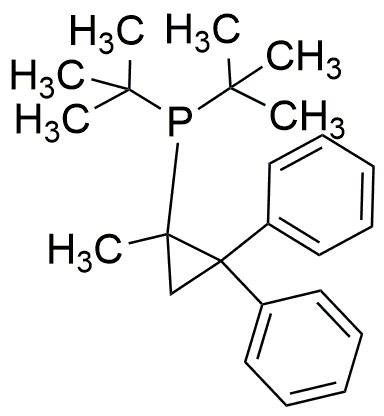Di-tert-butyl(1-methyl-2,2-diphenylcyclopropyl)phosphine is widely utilized in research focused on:
- Synthetic Chemistry: This compound serves as a versatile ligand in various catalytic reactions, enhancing the efficiency of chemical transformations in organic synthesis.
- Pharmaceutical Development: It plays a crucial role in drug discovery processes, particularly in the development of phosphine-based compounds that exhibit biological activity.
- Material Science: The chemical is used in the formulation of advanced materials, contributing to the development of polymers with improved properties such as thermal stability and mechanical strength.
- Catalysis: It is employed in transition metal catalysis, facilitating reactions that are vital in producing fine chemicals and agrochemicals, thus streamlining industrial processes.
- Research Applications: Researchers utilize this compound in studies related to organophosphorus chemistry, exploring its reactivity and potential applications in various chemical fields.
General Information
Properties
Safety and Regulations
Applications
Di-tert-butyl(1-methyl-2,2-diphenylcyclopropyl)phosphine is widely utilized in research focused on:
- Synthetic Chemistry: This compound serves as a versatile ligand in various catalytic reactions, enhancing the efficiency of chemical transformations in organic synthesis.
- Pharmaceutical Development: It plays a crucial role in drug discovery processes, particularly in the development of phosphine-based compounds that exhibit biological activity.
- Material Science: The chemical is used in the formulation of advanced materials, contributing to the development of polymers with improved properties such as thermal stability and mechanical strength.
- Catalysis: It is employed in transition metal catalysis, facilitating reactions that are vital in producing fine chemicals and agrochemicals, thus streamlining industrial processes.
- Research Applications: Researchers utilize this compound in studies related to organophosphorus chemistry, exploring its reactivity and potential applications in various chemical fields.
Documents
Safety Data Sheets (SDS)
The SDS provides comprehensive safety information on handling, storage, and disposal of the product.
Product Specification (PS)
The PS provides a comprehensive breakdown of the product’s properties, including chemical composition, physical state, purity, and storage requirements. It also details acceptable quality ranges and the product's intended applications.
Certificates of Analysis (COA)
Search for Certificates of Analysis (COA) by entering the products Lot Number. Lot and Batch Numbers can be found on a product’s label following the words ‘Lot’ or ‘Batch’.
*Catalog Number
*Lot Number
Certificates Of Origin (COO)
This COO confirms the country where the product was manufactured, and also details the materials and components used in it and whether it is derived from natural, synthetic, or other specific sources. This certificate may be required for customs, trade, and regulatory compliance.
*Catalog Number
*Lot Number
Safety Data Sheets (SDS)
The SDS provides comprehensive safety information on handling, storage, and disposal of the product.
DownloadProduct Specification (PS)
The PS provides a comprehensive breakdown of the product’s properties, including chemical composition, physical state, purity, and storage requirements. It also details acceptable quality ranges and the product's intended applications.
DownloadCertificates of Analysis (COA)
Search for Certificates of Analysis (COA) by entering the products Lot Number. Lot and Batch Numbers can be found on a product’s label following the words ‘Lot’ or ‘Batch’.
*Catalog Number
*Lot Number
Certificates Of Origin (COO)
This COO confirms the country where the product was manufactured, and also details the materials and components used in it and whether it is derived from natural, synthetic, or other specific sources. This certificate may be required for customs, trade, and regulatory compliance.


